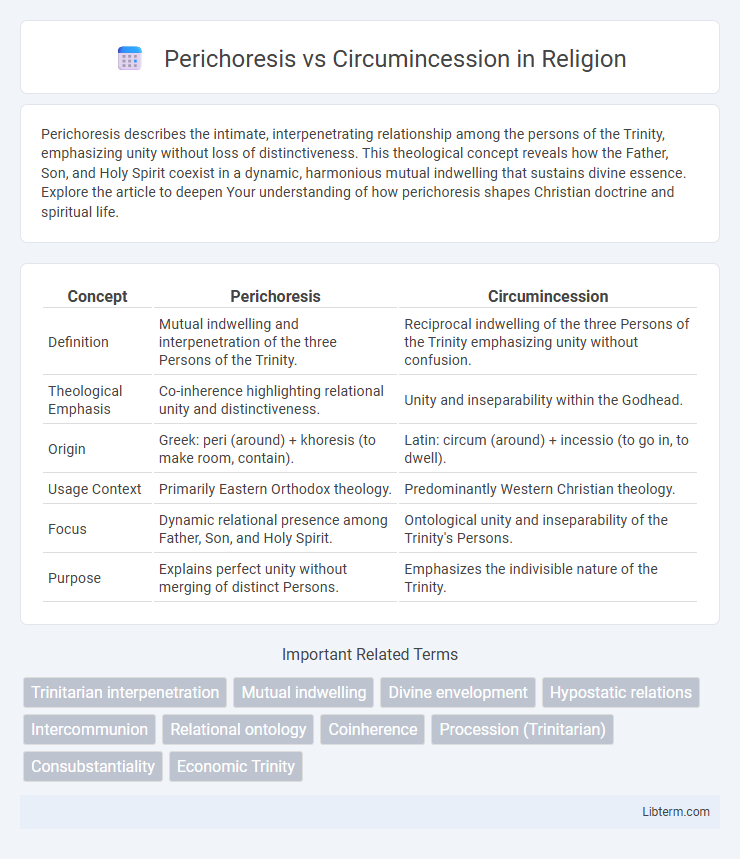Perichoresis describes the intimate, interpenetrating relationship among the persons of the Trinity, emphasizing unity without loss of distinctiveness. This theological concept reveals how the Father, Son, and Holy Spirit coexist in a dynamic, harmonious mutual indwelling that sustains divine essence. Explore the article to deepen Your understanding of how perichoresis shapes Christian doctrine and spiritual life.
Table of Comparison
| Concept | Perichoresis | Circumincession |
|---|---|---|
| Definition | Mutual indwelling and interpenetration of the three Persons of the Trinity. | Reciprocal indwelling of the three Persons of the Trinity emphasizing unity without confusion. |
| Theological Emphasis | Co-inherence highlighting relational unity and distinctiveness. | Unity and inseparability within the Godhead. |
| Origin | Greek: peri (around) + khoresis (to make room, contain). | Latin: circum (around) + incessio (to go in, to dwell). |
| Usage Context | Primarily Eastern Orthodox theology. | Predominantly Western Christian theology. |
| Focus | Dynamic relational presence among Father, Son, and Holy Spirit. | Ontological unity and inseparability of the Trinity's Persons. |
| Purpose | Explains perfect unity without merging of distinct Persons. | Emphasizes the indivisible nature of the Trinity. |
Introduction to Perichoresis and Circumincession
Perichoresis and circumincession both describe the profound interrelationship and mutual indwelling of the three Persons in the Holy Trinity, emphasizing their unity without confusion or division. Perichoresis, derived from the Greek term meaning "mutual indwelling," highlights the dynamic relational movement among the Father, Son, and Holy Spirit. Circumincession similarly underscores this intimate coexistence, stressing the circular interpenetration that preserves distinct personhood within divine oneness.
Etymology and Linguistic Origins
Perichoresis derives from the Greek peri- ("around") and chorein ("to contain" or "make room for"), emphasizing mutual indwelling and interpenetration in Trinitarian theology. Circumincession stems from the Latin circum ("around") and incedere ("to go"), highlighting the concept of the divine persons encircling or co-inhering within the Godhead. Both terms reflect distinct linguistic roots that shape their theological nuances regarding the relationship between the Father, Son, and Holy Spirit.
Historical Development of the Terms
The terms Perichoresis and Circumincession both describe the interpenetration and mutual indwelling of the Father, Son, and Holy Spirit within the Trinity, but their historical development differs significantly. Perichoresis, derived from the Greek perikhoresis, emerged prominently in Eastern Orthodox theology through the works of Church Fathers like Gregory of Nazianzus and John of Damascus between the 4th and 8th centuries. Circumincession, a Latin term rooted in the scholastic tradition of Western Christianity during the Middle Ages, particularly in the writings of Thomas Aquinas, reflects the Western Church's conceptualization of divine unity and co-inherence, highlighting subtle theological and linguistic distinctions shaped by cultural contexts.
Perichoresis in Trinitarian Theology
Perichoresis in Trinitarian theology describes the mutual indwelling and interpenetration of the Father, Son, and Holy Spirit without blending or division, emphasizing their unity in essence and distinction in personhood. This concept illustrates the dynamic relationship and co-inherence among the three divine persons, ensuring that each person fully participates in the life of the others while maintaining personal identity. Unlike circumincession, which is often considered interchangeable, perichoresis highlights the relational and ontological movement within the Godhead, reflecting an eternal communion of love and concurrence.
Circumincession in Doctrinal Context
Circumincession, also known as perichoresis, is a pivotal concept in Christian Trinitarian doctrine that describes the mutual indwelling of the Father, Son, and Holy Spirit without merging their distinct persons. This theological principle emphasizes the unity and co-inherence of the Trinity, maintaining both the individuality and inseparability of each divine person. Understanding circumincession deepens the comprehension of the relational and ontological harmony within the Godhead, crucial for articulating orthodox Christian belief on divine nature.
Similarities between Perichoresis and Circumincession
Perichoresis and Circumincession both describe the interpenetration and mutual indwelling of the three Persons of the Trinity, emphasizing their unity without confusion or division. These theological concepts capture the relational dynamic where the Father, Son, and Holy Spirit coexist in reciprocal presence and infinite love. Each term highlights the profound mystery of the divine essence shared fully and equally among the Trinity's distinct Persons.
Key Differences in Meaning and Usage
Perichoresis refers to the mutual indwelling and interpenetration of the three persons of the Trinity, emphasizing their unity without merging their distinct identities. Circumincession also denotes the interpenetration among the Trinity but is more frequently used in Latin theological discourse to express the idea of co-inherence. While both terms highlight the intimate relationship within the Godhead, perichoresis focuses on relational movement and shared life, whereas circumincession centers on the ontological coexistence and reciprocal indwelling.
Theological Significance in Christian Thought
Perichoresis and circumincession both describe the interpenetration and mutual indwelling of the Trinity's three persons--Father, Son, and Holy Spirit--highlighting their intimate unity without loss of individual identity. Theological significance lies in affirming the co-equality and co-eternity of the divine persons, safeguarding against heresies like modalism and tritheism. These concepts underscore the dynamic relationality within the Godhead, which serves as a model for Christian community and relationality in ecclesiology and soteriology.
Contemporary Interpretations and Debates
Contemporary interpretations of Perichoresis emphasize the dynamic relationality and mutual indwelling within the Trinity, reflecting modern theological efforts to articulate divine unity without collapsing individual distinctions. Debates often center on the compatibility of Perichoresis with contemporary metaphysical and relational ontologies, challenging traditional notions of static essence by proposing a more fluid interpenetration of persons. Circumincession, while historically synonymous, is increasingly scrutinized for its implications on the boundaries of personhood and the balance between unity and individuality in Trinitarian theology.
Conclusion: The Relevance of Perichoresis and Circumincession Today
Perichoresis and circumincession remain vital theological concepts for understanding the intimate unity and co-inherence of the Trinity in contemporary Christian doctrine. These terms illuminate the dynamic relationality and mutual indwelling of Father, Son, and Holy Spirit, shaping modern ecumenical dialogues and Trinitarian spirituality. Their ongoing relevance encourages a deeper appreciation of divine communion and the interconnectedness inherent in Christian faith today.
Perichoresis Infographic

 libterm.com
libterm.com